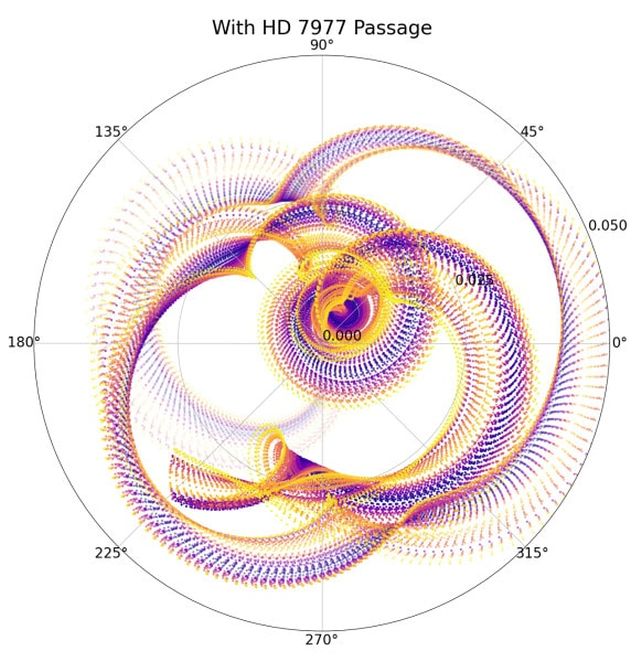ARTICLE AD
A grazing encounter between the Solar System and a passing star could once have changed Earth's orbit enough to wreak havoc on the climate, new research has found.
Around 56 million years ago, at the boundary between the Paleocene and Eocene, Earth's temperature warmed by up to 8 °C (14.4 °F).
This has always been a bit of a puzzle – but planetary scientist Nathan Kaib of the Planetary Science Institute and astrophysicist Sean Raymond of the Laboratory of Astrophysics of Bordeaux suggest a chance encounter may have been the culprit.
Their simulations show that a star passing by the Solar System could have introduced enough disruption to planetary orbits to nudge Earth slightly off course.
"One reason this is important is because the geologic record shows that changes in the Earth's orbital eccentricity accompany fluctuations in the Earth's climate," Kaib says.
"If we want to best search for the causes of ancient climate anomalies, it is important to have an idea of what Earth's orbit looked like during those episodes."
 An illustration of the uncertainty of Earth's orbit 56 million years ago, due to the passage of a Sun-like star similar to HD 7977. (N. Kaib/PSI)
An illustration of the uncertainty of Earth's orbit 56 million years ago, due to the passage of a Sun-like star similar to HD 7977. (N. Kaib/PSI)Piecing together the changes our planet has undergone in its 4.5 billion-year lifespan involves some impressive detective work. It often takes a combination of geology, modeling, and statistical analysis to reveal the finer details.
Based on the geological record, we know that Earth warmed by more than 5 to 8 °C during the period known as the Paleocene-Eocene Thermal Maximum. We also understand that dramatic changes in Earth's climate can correlate to changes in the way Earth orbits the Sun. But, well, modeling the orbital evolution of the Solar System over time is tricky.
"It has already been proposed that Earth's orbital eccentricity was notably high during this event," Kaib explains, "but our results show that passing stars make detailed predictions of Earth's past orbital evolution at this time highly uncertain, and a broader spectrum of orbital behavior is possible than previously thought."
Generally, scientists try to reconstruct the evolution of Earth's orbit by attempting to 'rewind' the Solar System in simulations. But, the researchers say, these simulations only include the Solar System in isolation, and don't take into account the large, populous, and dynamic galaxy within which it resides.
Although there is a lot of empty space in space, everything in the galaxy is moving, and not on the same orbit, trajectory, or speed. Other stars may zoom past the Sun as they go about their own star business. And, if this were to happen, the gravitational interaction with the Solar System could have an effect on the planets.
The Solar System is relatively stable, but orbits can be tweaked, and fairly easily. Earth's orbit, for instance, is regularly tugged about by the giant planets, which enact long-period changes on its orbital eccentricity, axial tilt, and precession.
These changes, taking place over tens of thousands of years, are called Milankovitch cycles, and we have a pretty good handle on them.
frameborder="0″ allow="accelerometer; autoplay; clipboard-write; encrypted-media; gyroscope; picture-in-picture; web-share" allowfullscreen>
Kaib and Raymond wanted to know if a passing star could have a similar effect, even from a significant distance. Their work focused on a single known event. Some 2.8 million years ago, a Sun-like star called HD 7977 passed the Solar System, potentially so closely that it flew inside the Oort Cloud.
It may have flown past at a distance of some 31,000 astronomical units; that's 31,000 times the distance between Earth and the Sun, and too far to have had much effect. But it may have zoomed in as close as 4,000 astronomical units.
Upon conducting their simulations, the researchers consistently found the distances closer to the smaller end of the range had some sort of gravitational influence on the movements of the planets in relation to the Sun.
HD 7977 is one star, and the only flyby we can confidently identify. But scientists have estimated that a star passes by within 50,000 astronomical units every million years or so, and within 10,000 astronomical units every 20 million years or so.
This means that it's entirely possible that a passing star has affected Earth's climate in the past – and may even have played a role in the thermal maximum.
Future studies on the long-term evolution of the Solar System really ought to take these passers-by into account, Naib and Raymond say.
"We show that stellar encounters play an important role in our Solar System's long-term dynamical evolution," they write in their paper.
"Although it takes tens of millions of years for the effects of stellar passages to significantly manifest themselves, the long-term orbital evolution of the Earth and the rest of the planets is linked to these stars."
The research has been published in The Astrophysical Journal Letters.

 1 year ago
70
1 year ago
70 

